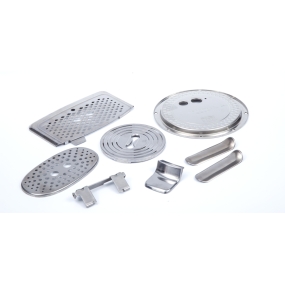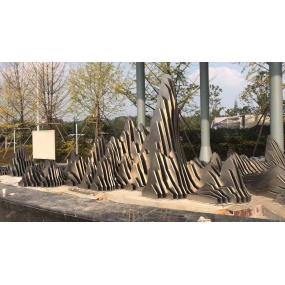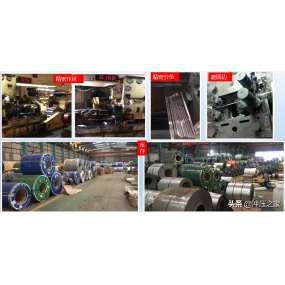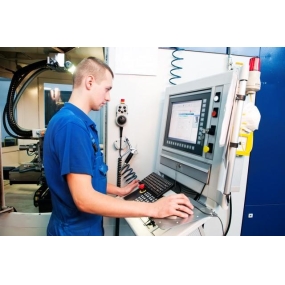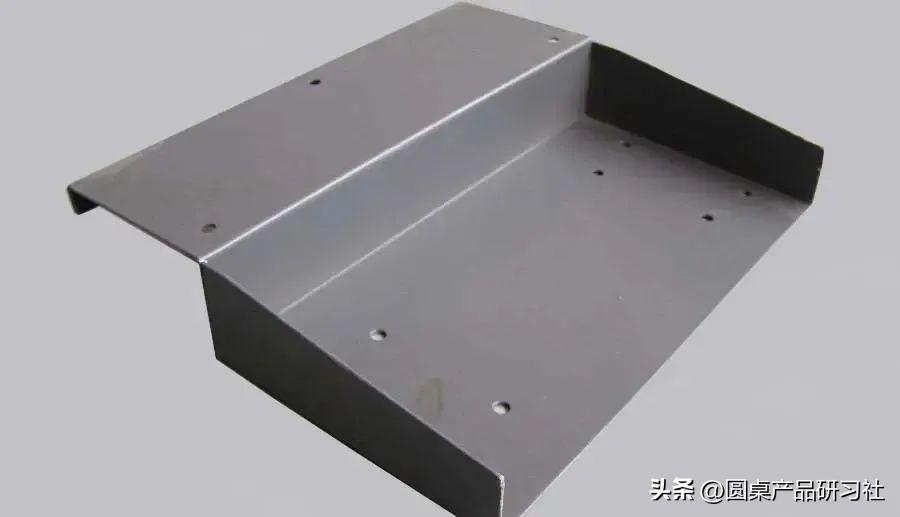
1, Folding bed processing content: 1. L folding is divided into 90 degree folding and non 90 degree folding according to the angle.
Secundo processionem divisum est in processionem generalem (L>V/2) et processionem specialem (L > Fula selecta est based on the material, plate thickness, and forming angle. 2> Principus fidei 1) Based on the principle of two rear positioning rules and positioning according to the shape of the workpiece. 2) When positioning a rear gauge, pay attention to deviation and ensure that it is on the same center as the bending size of the workpiece. 3) Bending small folds, it is better to process them in reverso position. 4) Melius est regulas ad rursum et ad mediumm ponere. (When leaning against the position, it is not easy for the rear regulation to lift) 5) Melius est prope extremum position is et posteriora regula esse. 6) Melius est ad longum laterem accendere. 7) Use fixtures to assist in positioning (irregular inclined edge positioning). 3> , Precautions 1. Attention should be paid to the positioning method during processing and the standardized movement mode among various positioning processing methods. 2. Quando conflatio congregata est, revertetur et revertetur ut non disformatur opus dum crescere. 3. When bending large workpieces internally, a cause of the large shape of the workpiece and the small bending area, it is difficult for the cutting tool and the bending area to coincide, resulting in difficulties in positioning the workpiece or damage to the bent workpiece. To avoid the above situation, a positioning point can be added in the longitudinal direction of the machining, so that the machining can be positioned from two directions, making the machining positioning convenient and improving the machining safety, avoiding workpiece damage, and enhancing production efficiency. 2. N-fold requires different processing methods depending on the shape. When bending, the internal dimensions of the material should be greater than 4MM, and the size of the X dimension is limited by the shape of the mold. Si mensura intra materiae minus quam 4MM est, modi speciales pro processione utili sunt. > Elegite molam basem super densitatem materiae, granditudinem, materiae, et angulum bending. 2> Principus fidei 1) Ensure that the workpiece does not interfere with the tool 2) Ensure that the positioning angle is slightly less than 90 degrees. 3) Melius est duos regnos posteriores, except is circumstantibus. 3> , Precautions 1) Post bending L, angulum ad aut paululum minus quam 90 gradus servare ut machinationem et positionem facilitaret. 2) In secundo colligatione, requirit positionem cum superficie machinationis ad centrum alignere. 3. Z-bend, also known as segment difference, refers to the bending of one positive and one negative. Divide partem partem inter angulum et segmentum rectum inter angulum secundum angulum. Dimensio minima pro fermento processionis limitata est a fermento processionis, dum maxima mensura processionis determinata est a forma machinae processionis. In general, when the internal size of Z-folded material is less than 3.5T, segmented die processing is used. Quando maior est quam 3,5T, modi processionis normale utili sunt. > Principus fidei 1) Convenient positioning and good stability. 2) Usually, the positioning is the same as the L fold. 3) Posicio secundari requirit, ut articulum processum conflictem subter molam. 2> , Precautions 1) Angulus processionis L foldae in loco oportet, generalmente inter 89,5-90 gradus esse. 2) When pulling back according to the later specifications, attention should be paid to the deformation of the workpiece. 3) Ordine processionis recta est. 4) Pro specioso processione, sequentes metodes utilizatur: Centre line separation method (eccentric machining) Parvus V processus (coefficientem crescere requirit) Easy to mold forming Grinding the lower mold 4. Reverse folding and flattening, also known as edge compression. Exeductiones ad terminos mortuos sunt: 1. Bend and insert into a depth of about 35 degrees first. 2. tunc flatum et fusum donec splendetur et adheretur. > Method Selection Modeli Select the V-groove width of the lower mold with a depth of 30 degrees according to 5-6 times the material thickness, and choose the upper mold according to the specific situation of processing dead ends. 2> , Precautions Attention should be paid to the parallelism of both sides of the dead edge. When the processing size of the dead edge is relatively long, the flattened edge can be folded at a raised angle first and then flattened. For shorter ends dead, padding procession can be used. 5. Pressing hardware uses a folding bed to press and seal hardware components, usually using auxiliary molds such as concave molds and fixtures for processing. In general, there are: compression nuts, compression bolts, compression screws, and other hardware components. Processing precautions: 1. When the shape of the workpiece needs to be avoided during machining, avoidance measures should be taken. 2. Post processionem, necesse est verificare si torcular et torcular conformentur ad standardes, et si hardware et obrus fluctus sunt et stricto attachi. 3. After bending and pressing, when pressing next to the machine tool, pay attention to the machining avoidance and parallelism of the mold. 4. Si magnitudo est, est etiam importantium notare non esse fractura in extremis extremis, et extremis extremis super superficiem opus. 6. Contenium processionis facilis molationis generale includent: minores differences, hooks, bridges, saccos, pressure springs, et alios irregularis formas. The design principle of Easy Mold refers to the "Laser Cutting Easy Mold Design Principle" Easy to mold generally uses post positioning or self positioning. Præceptione supra contentio cum facile molda est quod functionem eius et necessitates congregationis non affectantur, et apparentia normal est 2 , Common problems and solutions in folding bed processing: 1. Analysis of the causes of sliding during processing: 1. Elegite molam ferentem, latitudinem V-groove de (4-6) T generale elegitur. Quando magnitudo bend is minor est quam dimidiae latitudinis selectae V-grove, occurrit fenomenus glissantis. 2. Plaza V elegita nimis magna est 3. Processus Solution method 1. Center line deviation method (eccentric machining). Si mensurae interiora materiae fermenti minus sunt quam (4-6) T/2, constitue differentiam maxime possibilis 2. Pad processing. 3. Bend a small V-groove and apply pressure with a large V-groove. 4. Minimum plagam V elige. 2. Analisi causarum quam latitudinem interiorem inclinationis angustissima est quam latitudinem standard mollium: Pro minimam latitudinem standardissimam litoris folding mold est 10MM, partis fermenti habet latitudinem minus quam 10MM. Si 90 gradus est, dimension longitudinis eius non minus est quam 2 (L+V/2)+T. Hoc enim typum fermenti fixatum est fabrum super sedem fermenti (exceptis libertatem non constraintum in directo supra) ut non evaderet displaciationem fabris, quod potest causare opus dispersi aut causare accidentes securitatis. Solutione: > Increase magnitudinem (coherendi cum clientes), id est, magnificare latitudinem intrinsecus. 2> Easy to mold processing 3> Instrumentos gravitationis (quae ad incrementum negotiarum processionis ducit) 3. Raeda nimis proxima est linea crescintis, et crescintis crescit foras materiae pullare. Analisi rationibus flictionis: Assuminantes distancem inter forum et lineam inclinantem L est quando L At (4-6) T/2, the hole will pull the material. Mainly due to the stretching force during the bending process, the material undergoes deformation, resulting in the phenomenon of pulling and flipping. Secundo latitudinem standard mold grove existente, minimum valorem L pro diversis densitatibus plateae in sequente mensa monstratum est: Solutione: > Increase granditudinem et angulos colligit post formationem. 2> Expand the hole to the bending line (must have no impact on appearance or function, and the customer agrees). 3> Cut line processing or pressure line processing 4> Mold eccentric processing 5> Modify the hole size 4. Analisi causarum deformationis in puncto extraction post bending a causa parva distancia L inter edge extraction et liniam bending: Quando L<; At (4-6) T/2, due to the contact between the drawing and the lower mold, deformation occurs during the bending process due to the force exerted on the drawing. Solutione: > Cut an presse lineam. 2> Modify the drawing size. 3> Using special molds for processing 4> Mold eccentric processing 5. Analysis of the causes of warping after flattening the long edge of the dead: propter longum angulum mortuum non potest adherere cum flatatus fuerit et post flatationem extrema curvatur This situation is closely related to the flattened position, so attention should be paid to the flattened position when flattening Solutione: > Prius colligere extremum mortuum, primum collige angulum levatum (sicut in diagramma monstratum) et tunc splende illum. 2> Lingite in multis gradibus: Press the end first to bend the dead edge down. Radices splende. Attention: The flattening effect is related to the operator's operational skills, so please pay attention to the actual situation during flattening. 6. Analysis of the Reasons for the Easy Fracture of High Height Bridge Pulling: > Pro altitudinem ponti materia magna extenta est, resultit in fractura. 2> anguli conflationis non erunt nec satis pulsaverunt 3> Fortitudo materiae nimis pauper est aut corpus pontis nimis angustus est. Solutione: > Extende foras procedentis ad laterem fracturae. 2> Increase latitudinem ponti. 3> Lingite angulum R fuscini et cresce transitionem arcae. 4> Adde oleum lubricantem ad pontem suctionis. (igitur, hoc metodo faciet superficiem artificis sordidi, ita non potest ad partes AL, etc.) 7. Analysis of the reasons for the running of machining dimensions during easy mold processing: Due the forward compression force exerted on the workpiece during the machining process, the workpiece moves forward, resulting in an increase in the small rake angle L at the front. Solutione: > De umbra regionibus in imagine tene. Usually, the difference is made up as much as possible. 2> Extingite omnes partes in positionibus suis molae et converse ad positionem fixiam. (As shown in the figure below) 8. Tota granditudo materiae (referentia ad dispersionem) nimis parva aut nimis magna est, quae non correspondit ad superficiem circularem. Cause analysis: > Projectus incorrecte lanceatus est. 2> Dimensio sequitur incorrecta est. Solutione: Calculate deviationem allocatam pro singulis bandis based on the total deviation in the direction of deviation and the number of bending blades. Si tolerans allocation is calculata est intra tolerantiam, opus acceptabilis est. Si magnitudo nimis est, parva V-groove pro processione utilizatur. Si magnitudo nimis est, magna V-groove pro processione utilizatur. 9. Analisi deformationis causis expansione vel libertate fit post fluctum punching et mortification: > Swelling is caused by the R angle of the hole punch being too small or the burns on the flange being too large. 2> Non adequate expansione foraminis est. 3> Deformatio a hole mislignment aut incorrecta method of mating potest causare. Solutione: > Elegite punctum magnum R-angulum in loco. Attention: Burges around the hole during hole drawing and flanging. 2> Increase pressure, expande and deepen the salad hole, and use a punch with a large R-angle instead. 3> Methodus excavationis rationibus variationis methodos mationis et foraminis misligationis. 10. Analysis of the causes of skewness or deformation of the workpiece after screw pressing: > Produkt işlemlerinde kırık parçalar yok. 2> Uneven force or excessive pressure on the lower surface of the workpiece. Solutione: > When pressing the screw, the workpiece should be levelled. 2> Make a support frame. 3> Adjust the pressure again. 4> Increase radicem fortitudinis super superficiem inferiorem et diminue radicem fortitudinis applicationis super superficiem. 11. Analysis of the reasons for the non parallelism between the two sides after the segment difference: > Fula non calibrat. 2> Gasticos superiores et inferiores non rectae sunt. 3> Eleccio superioris et inferioris superficium dessimilis est. Solutione: > Calibrate molam. 2> Adde aut remove shims. (For specific adjustment methods, please refer to "Segment Processing Technology") 3> Fula eccentrica est. 4> replete faciem ut superficies molarum superiorum et inferiorum similes sint 12. Analysis of the reasons for the deep creases on the surface of the product: > The V-groove of the lower mold is small 2> Anglus R anguli V-grove in mola inferiora parvus est 3> Materium nimis tenet. Solutione: > Great V-groove processing 2> Using a mold with a large R-angle for processing 3> , cushion material bending (cushion steel sheet or Yuli glue) 13. Analisi causarum deformationis iuxta punctum bending post bending: Maquina celeriter in processo fermenti curret, et velocitas fermenti supra fermenti laboris in deformatione maior est quam velocitas in qua operator motum laboris manus suas suscepit. Solutione: > Reduce velocitatem operationis machinae 2> Increase velocitatem manus operatorum. 14. Analysis of the causes of cracking in AL parts during bending: Pro universa crystala structura materiae AL, fractura prona est, quando paralelum cum oriente tritici fertur. Solutione: > Cum sequitur, considerate rotationem materiae AL perpendiculare ad direction bending (etiam si direction bending materiae perpendiculare est grano). 2> Increase angulum R molae superioris.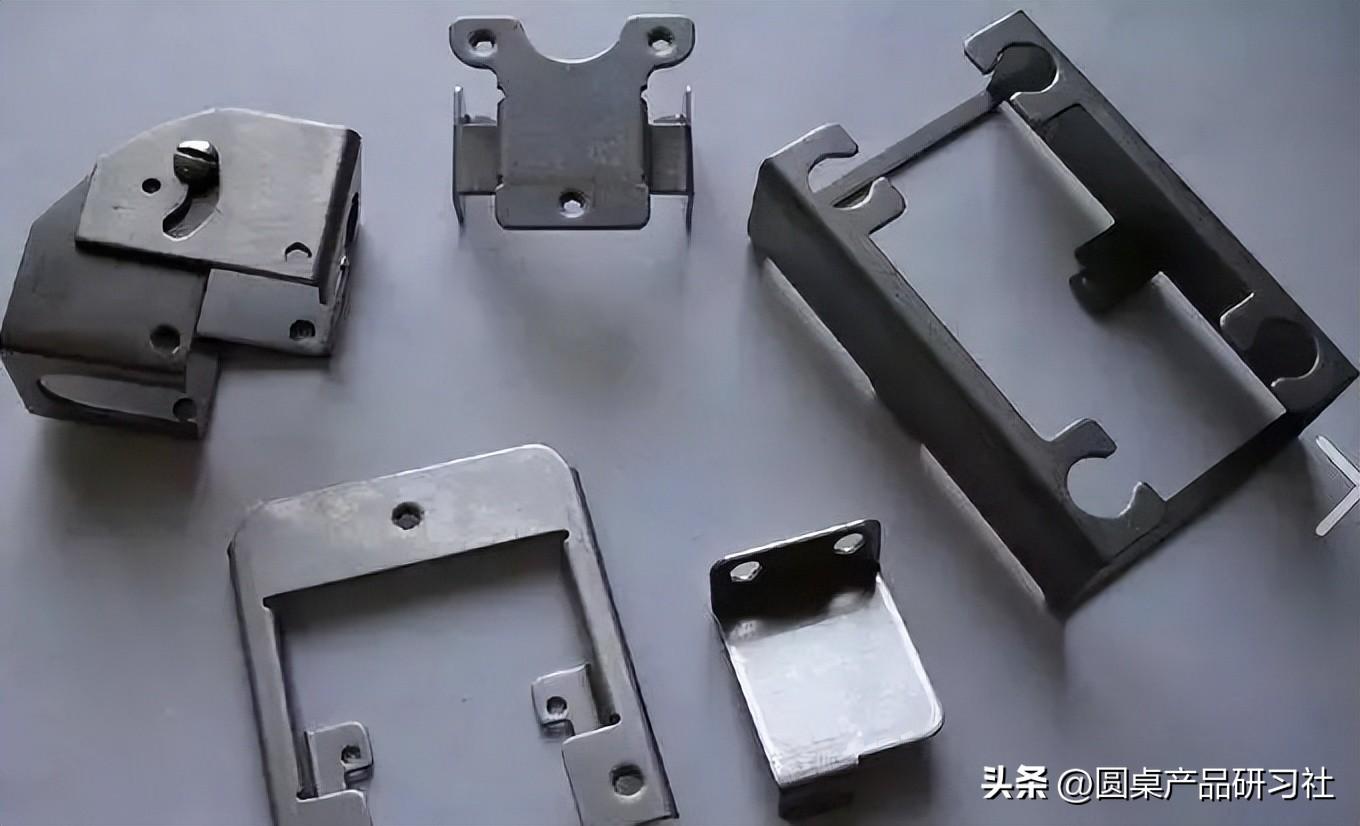


 English
English Spanish
Spanish Arabic
Arabic French
French Portuguese
Portuguese Belarusian
Belarusian Japanese
Japanese Russian
Russian Malay
Malay Icelandic
Icelandic Bulgarian
Bulgarian Azerbaijani
Azerbaijani Estonian
Estonian Irish
Irish Polish
Polish Persian
Persian Boolean
Boolean Danish
Danish German
German Filipino
Filipino Finnish
Finnish Korean
Korean Dutch
Dutch Galician
Galician Catalan
Catalan Czech
Czech Croatian
Croatian Latvian
Latvian Romanian
Romanian Maltese
Maltese Macedonian
Macedonian Norwegian
Norwegian Swedish
Swedish Serbian
Serbian Slovak
Slovak Slovenian
Slovenian Swahili
Swahili Thai
Thai Turkish
Turkish Welsh
Welsh Urdu
Urdu Ukrainian
Ukrainian Greek
Greek Hungarian
Hungarian Italian
Italian Yiddish
Yiddish Indonesian
Indonesian Vietnamese
Vietnamese Haitian Creole
Haitian Creole Spanish Basque
Spanish Basque


